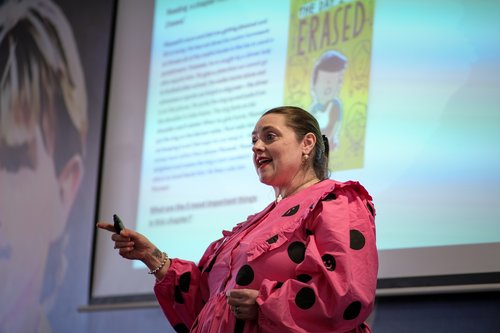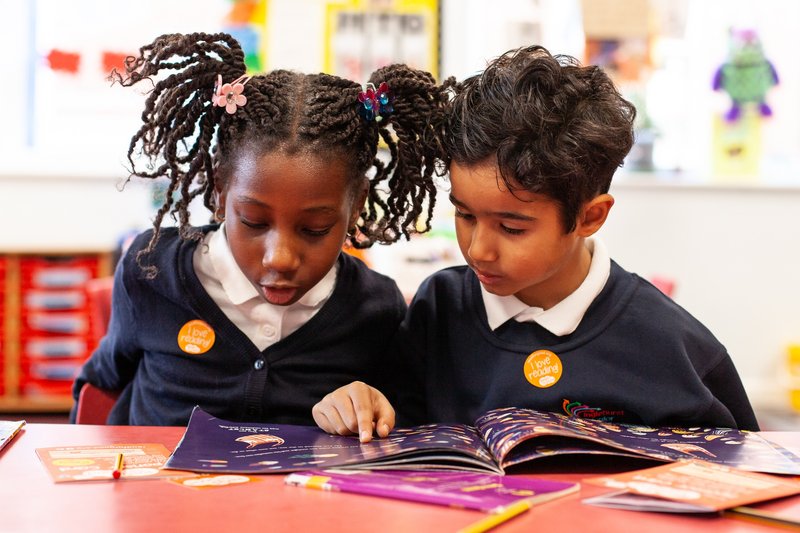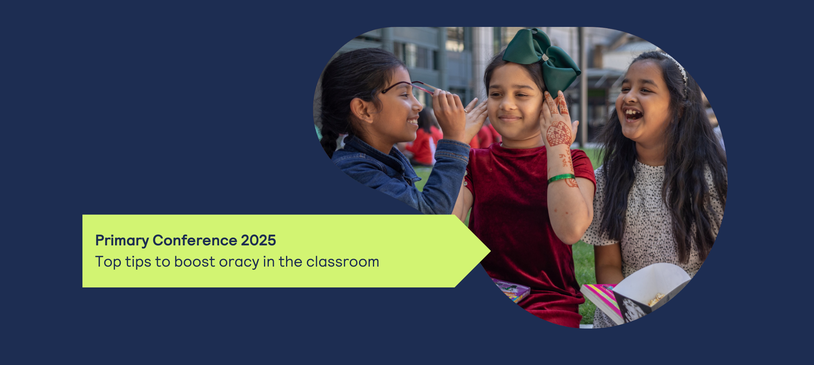At the Primary Conference 2025, our line up of oracy and literacy experts explored how we can boost the voice of every child in the primary classroom. With our conference theme, ‘Raising voices, raising literacy’, we considered how to empower confident communication across written and oral ability for KS1-3.
In this article for TeachBrief, we’ll look at the key practical takeaways for supercharging oracy in the classroom. Don’t forget to check the end of this article, where we’ll provide resources to help implementation.
If you couldn’t join us this year, we hope to see you at our next conference. For CPD on boosting oracy outcomes in your primary school, register for our Developing oracy in KS1 & KS2 training.

Reading expert Maddy Barnes explored opportunities in book talk to validate children's perspectives.
How can we foster confident communication in the primary classroom?
1. It starts with you!
- “Are we teaching reading the way we WANT to or the way we HAVE to?” This was the question leading our workshop with reading expert Maddy Barnes, who invited us to reflect on how we deliver reading. Namely: What dictates how we teach reading? Do our pupils enjoy learning reading? Maddy explored how we can develop book talk practice to be more inclusive. What we might consider more “opinionated” or “creative” responses are worth exploring – where does the child’s perspective come from? By engaging with these individual responses, we better support children’s confidence in expressing themselves. In addition, it exposes your pupils to new ways of thinking.
- Focusing on poetry, teacher and facilitator Jonny Walker discussed the importance of teachers finding texts that they enjoy themselves. When you’re bringing authentic readings to classroom discussions, this will encourage pupil’s responses - and their own enthusiasm. Jonny recommended exploring poetry for yourself. The Children’s Poetry Archive has a huge range of texts available to browse, some with audio readings. Find what resonates with you. Spending time exploring texts can also help you broaden the pedagogy, and find voices which reflect your pupil’s individual backgrounds and experiences.
“Let’s deepen our own reading, to deepen our teaching."
Jonny Walker

The texts we choose in the classroom can validate pupil's experiences - and voices.
2. Nurture individual voices
- Author, broadcaster and former teacher Jeffrey Boakye highlighted the significant role teachers have in social and racial injustice. Jeffrey pointed out that the children most likely to be excluded are black Caribbean, and/or those with additional speech, communication and learning needs. It is necessary to reflect on our own practice: how are we meeting the needs of each pupil in the classroom? Are we supporting all communication styles? This needs to be embedded across the whole setting. Encouraging conversations with your colleagues can help group reflection on how this currently looks in your setting. Is this an area that could be worked on? What do you need to support this?
- This also applies to the curriculum, and how we facilitate these discussions in class. Can we expect pupils to engage with a curriculum where they are not represented? Children’s author AM Dassu explored how seeing their own experiences reflected in stories can help them feel validated, and encouraged to communicate their perspectives. A more diverse range of texts also supports an increased awareness of difference, and ability to identify bias.
3. Reframe our understanding of ability
"Teaching oracy is like music."
Lauren Kearney, English Speaking Board
- Lauren Kearney from the English Speaking Board demonstrated different approaches to oracy that support a range of needs and communication styles, particularly the needs of EAL learners. Exercises focusing on prosody can better support the development of their communication skills – for example, identifying tones of voice in a written or spoken text.
- What do we think of as “good” writing? Education expert James Durran addressed how, with creative writing exercises, feedback often focuses on technical ability as opposed to the purpose and audience of the text. James demonstrated ways to model writing exercises which improve pupil’s abilities, as well as reframe how their abilities are measured. For example, starting with the purpose of the text, we can work with pupils to develop an outline of how this purpose can be met – asking not only the how of the text, but also the why.

Authentic language and self-expression can be encouraged through creative writing, poetry and performance.
4. Create space for self-expression and creativity
- Allow chat! Across our line up there was a strong recommendation for harnessing chat – which is where we see what children really think and feel. Whether reading together or responding to a text, allow space for authentic responses. Exploration with no wrong or right answers. As Maddy Barnes emphasised, “Expect the unexpected!”
- Author and poet Matt Goodfellow encouraged us to spend 5 minutes at the beginning of each lesson or day with a poem. Reciting or reading together – the key element is to encourage responsive chat. He emphasised the importance of freeform discussion that gives space for individual responses. “If someone is asking questions about a poem,” he added, “that means they’ve already decided that they know what the poem means.” Over time, this practice could help to break down barriers to understanding poetry and creative expression, supporting pupils to identify and communicate their own perspectives.
- Alternative rapper Wilko Wilkes emphasised how children’s individual expression and stories can be empowered through creative writing and performance. When facilitating spoken word and rap workshops, Wilko gives children this guidance: “It’s okay to use your imagination – if you want to make up a word and put it into your writing, that’s okay... We can work on it and put it in there.”
How can I implement these tips into my classroom practice?
We hope these takeaways will be useful for boosting oracy in your primary classroom. Here’s a selection of resources to support embedding these key learning points.
Related resources for practitioners:
Writing poems with Paul Cookson | National Literacy Trust
Talk for reading: a reading and oracy staff workshop | National Literacy Trust
